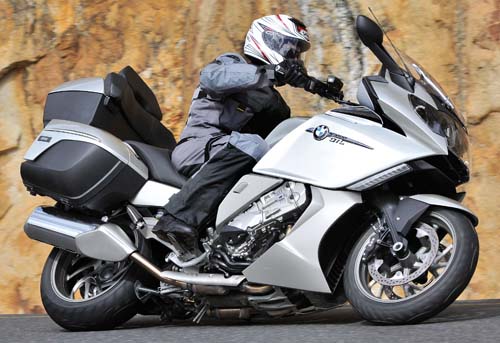
Two years ago, at the press introduction for the 2009 BMW K 1300 GT and K 1300 S, Pieter de Waal, VP of BMW Motorrad USA, outlined the German manufacturer’s new strategy. No longer satisfied with its reputation for building quirky, expensive motorcycles for the “pipe and slippers” brigade, BMW sought to broaden its appeal. It made small changes, like phasing out three-button turn signals on some models. And it made big changes, like introducing the 2010 S 1000 RR, a price-competitive superbike that has won shootouts and exceeded sales projections. The strategy worked. BMW has gained market share and last year its sales were up 12 percent.
BMW’s all-new K 1600 GT and K 1600 GTL are a double-barreled blast at the sport-touring and luxury-touring segments. I rode both bikes at the world press launch in South Africa, and I’m still trying to pick my jaw up off the floor. Just as the S 1000 RR set new standards for power and technology in the sportbike class, the K 1600s raise just about every touring benchmark we can think of. Fraternal twins, the GT and GTL have many similarities but unique personalities. Engine, chassis and bodywork are the same, but bike-rider interfaces differ. With sportier ergonomics, suspension and sound, the K 1600 GT is optimized for solo sport touring. More relaxed and plush seating, better wind protection, a larger fuel tank and a standard top trunk make the K 1600 GTL ideally suited for long-distance, two-up expeditions. Both models have honkin’ power and an unsurpassed level of sophistication and refinement.
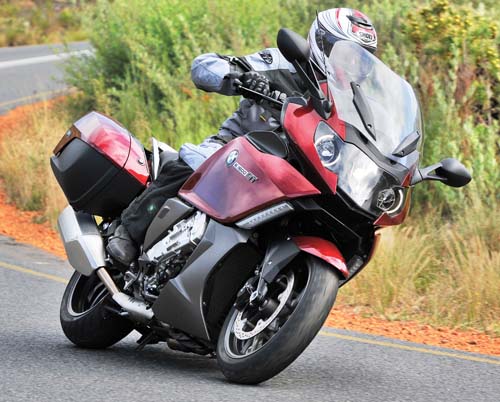
At center stage is the new 1,649cc in-line six-cylinder engine. BMW says it tips the scales at 226 pounds, measures 21.9 inches in width and produces 160 horsepower and 129 lb-ft of torque at the crankshaft, which makes it the most compact and powerful six-cylinder motorcycle engine available. The Honda GL1800 Gold Wing’s 1,832cc boxer was the only six-cylinder motorcycle engine in current production, and an in-line six hasn’t been seen since the ’80s. The K 1600 engine’s slender beam, barely more than an open-class in-line four’s, is made possible by a narrow 72mm bore (stroke is 67.5mm) and cylinder sleeves spaced just 5mm apart. Electrical and drive components are located behind the crankshaft, above the gearbox. The perfect primary and secondary balance of an in-line six eliminates the need for counterbalancers, which along with lightweight engine materials and components, saves more space and weight. As with previous K-bikes, the 1600’s cylinders are canted forward 55 degrees, which lowers the center of gravity, puts more weight on the front wheel and allows the frame rails to pass over rather than around the engine.
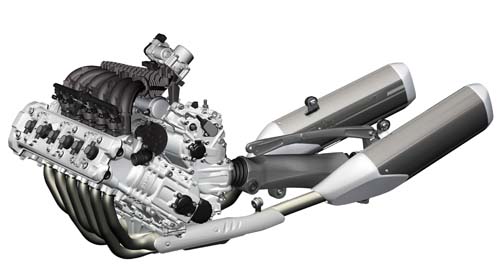
After two days of riding the GT and GTL for hundreds of miles over mountain passes, through valleys and along the coast near Cape Town, I’m hopelessly addicted to the sound, feel and power of the K 1600 engine. Our first day was spent aboard the majestic GTL. Leaving the hotel parking lot, a sumptuous symphony of six-cylinder engines quickly dissipated the last of our jet lag. The GTL’s exhaust note is deep and rich. With a 120-degree even firing sequence, the engine purrs at idle and roars like a supercar when cranked up. Spent gasses exit through a 6-into-2 exhaust system with dual catalytic converters and large-volume chrome silencers tucked beneath the saddlebags. The GT has the same setup, but with a more aggressive engine tune and brushed aluminum canisters. The K 1600 engine is velvety smooth with minimal vibration but never feels dull. Power climbs steadily from 1,000 rpm up to the 8,500-rpm redline, reaching its claimed 160-horsepower peak at 7,750 rpm. Even more impressive is the enormous amount of torque that’s available anytime, anywhere. BMW says the K 1600 produces 129 lb-ft at 5,250 rpm, more than 70 percent of which is on tap starting at 1,500 rpm. Weighing over 700 pounds each fully gassed, the GT and GTL are big bikes, but a handful of throttle makes them leap out of corners and streak to scenery-blurring speeds. With so much grunt, you can leave either bike in third or fourth gear and wind it out just to hear the wonderful sound. When you do shift, the clutch pull is light and the transmission changes gears easily.
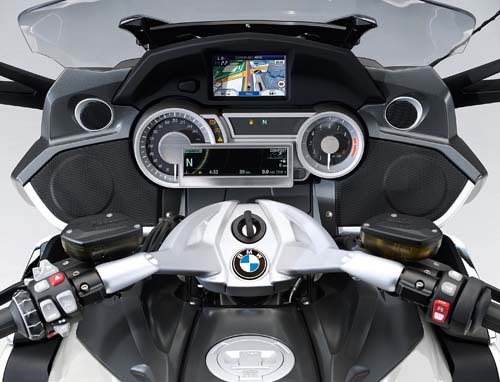
Smoothness is inherent in the K 1600 engine’s in-line six configuration, with extra silkiness courtesy of a lightweight crankshaft, camshafts, connecting rods and pistons that minimize frictional losses and conserve fuel. To further boost fuel efficiency, the GT and GTL get BMW’s latest BMS-X engine management system, a variable-pressure fuel pump and E-gas (throttle- by-wire). Throttle response was a bit vague at low speeds, but excellent otherwise. Low engine speed also reduces fuel consumption; the K 1600 engine barely turns 2,400 rpm at 60 mph in top gear. With a 12.2:1 compression ratio that requires premium fuel, BMW claims 52 mpg for the GT and 51 mpg for the GTL at a constant speed of 55 mph. Encouraging, but definitive fuel economy figures will have to wait until we thoroughly test each bike. Both have generous fuel capacity —6.3 gallons on the GT and 7 on the GTL.
In addition to optimizing fuel usage and throttle response, E-gas also enables riding modes, electronic cruise control and optional Dynamic Traction Control (DTC), which uses a gyroscopic sensor to account for lean angle in addition to wheel-speed sensors. A button on the right switchpod allows quick, on-the-go changes between the three riding modes—“Dynamic” for sport riding, “Road” for general-purpose riding and “Rain” for wet, slippery conditions. Similar to the Ducati Multistrada and Diavel, riding modes determine power output, throttle response and DTC level. “Dynamic” provides the quickest throttle response, full power and minimal DTC intervention; “Road” softens throttle response and increases DTC; and “Rain” reduces power, dials back throttle response and provides maximum DTC intervention. Changing between modes is seamless and all three work well, though “Rain” was superfluous in hot, dry South Africa where it was summertime in February.
When developing the K 1600s, BMW sought to keep the center of gravity low and mass centralized for nimble handling. The aluminum alloy bridge-type frame, aluminum subframe and BMW’s tried-and-true front Duolever and rear Paralever suspension with a single-sided swingarm and Cardan shaft drive are sturdy and responsive. Optional Electronic Suspension Adjustment (ESA) II allows push-button adjustability among nine possible damping settings: Sport, Normal or Comfort mode, plus solo rider, solo plus luggage or passenger plus luggage settings for preload. Damping was smooth and well-controlled on the GTL, with added firmness on the GT. BMW Motorrad Integral ABS, which links from front-to-rear only and includes an additional pressure sensor for greater sensitivity, is standard. The triple-disc brakes are powerful and easy to modulate with subtle ABS engagement, aided by Metzeler Roadtec Z8 tires with excellent grip. It took only a few corners to get comfortable on both bikes, and my confidence grew steadily. Steering was light and predictable at any speed, especially on the sportier, lighter GT. Both bikes felt unshakable; I’ve never ridden so fast with so much confidence and comfort.
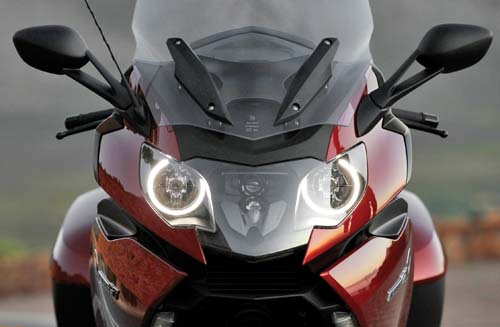
Standard equipment on both models includes a Xenon headlight, Multi-Controller, onboard computer, electronic oil-level sensor, heated grips and seat, cruise control, two 12V outlets and an electronically adjustable windscreen. First introduced on the R 1200 RT, the Multi-Controller is a dial between the left grip and switchgear that scrolls through and selects menu options, keeping the cockpit free of all but a few audio control buttons. Aided by a 5.7-inch full-color TFT display between the analog speedo and tach, it was intuitive to learn and use. The taller, wider windscreen on the GTL allows a wide range of adjustment and remembers its last setting; when the ignition is turned off it returns to the lowest position to prevent unwanted access to the built-in slot for the optional BMW Navigation IV GPS unit. Wind protection on the GTL was excellent, though in the screen’s highest setting there was strong back pressure and some helmet buffeting. Both were eliminated by opening the clever fairing vents which direct wind into the cockpit. The GT’s windscreen is shorter and narrower, and has a U-shaped cut-out at the top. I could see over the top in all positions, and there was no buffeting or back pressure when fully raised.
Both models come standard with 33-liter saddlebags, and the GTL adds a 49-liter top trunk with passenger backrest. Easy to open and close, each saddlebag holds a full-face helmet and the trunk holds two. Standard equipment on the GTL also includes an audio system, GPS preparation and wider rider/passenger footrests. Other options on our test bikes were a tire pressure monitor and a central locking system—pushbutton power locks for the two fairing storage pockets, saddlebags and (on the GTL) top trunk.
As with their differences in exhaust note, suspension and wind protection, the GT and GTL’s rider/passenger accommodations reflect their intended missions. Compared to the GT, the GTL’s seat—among the most comfortable I’ve ever experienced—is wider and more generously padded. I rode bikes equipped with the standard 29.5-inch seat; a taller 30.7-inch seat will be available at no extra cost. The GTL’s handlebars have 2 more inches of pullback and the rider’s footpegs are 2 inches farther forward and lower (measured diagonally). The ergonomic differences are readily apparent, but I had no complaints on either bike; in terms of rider comfort, they should stand up well against their competitors. However, the same may not hold true for passenger comfort. I got mixed reports from journalists who rode as passengers on both bikes. In particular, the sides of the GTL’s passenger backrest pushed their arms forward into an awkward position, and they complained that the wider seat left little room between it and the grab rails.
The K 1600 GT and GTL provide everything sport-touring or luxury-touring riders could want. Their power, handling, comfort and features will rival anything in their respective classes. Multiple riding modes and optional Dynamic Traction Control, ESA II and Adaptive Headlight (see below) allow riders to dial in their preferences and enjoy state-of-the-art safety. In dealers as early as May, the K 1600 GT will be available in three options/price configurations (base, $20,900; standard, $23,045; and premium, $24,540) and two colors: light gray metallic or vermilion red metallic. The K 1600 GTL will be available in two configurations (base, $23,200; premium, $25,845) and two colors: mineral silver metallic or royal blue metallic. You can find details on the options packages below or by visiting your nearest BMW dealer. Stay tuned for complete tests of both bikes and comparisons with their peers.
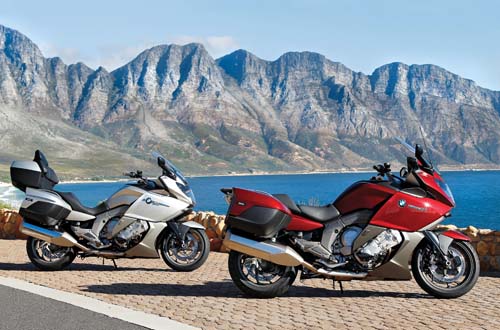 2012 BMW K 1600 GT (GTL) Specs
2012 BMW K 1600 GT (GTL) Specs
Base Price: $20,900 ($23,200)
Price as Tested: $24,540 ($25,845); Premium package (see below)
Website: bmwmotorcycles.com
Engine Type: Liquid-cooled, transverse, in-line six, DOHC, 4 valves per cyl.
Bore x Stroke: 72.0 x 67.5mm
Displacement: 1,649cc
Transmission: 6-speed, hydraulically actuated wet clutch
Final Drive: Shaft
Wheelbase: 66.1 in.
Rake/Trail: 27.8 degrees/4.3 in.
Seat Height: 31.9/32.7 in.; optional low seat: 30.7/31.5 in. (29.5 in.; optional high seat: 30.7 in.)
Claimed Wet Weight: 703 lbs. (767 lbs.)
Fuel Capacity: 6.3 gals. (7.0 gals.)
Average mpg: NA
SIDEBAR: Smart Headlight
The BMW K 1600 GT and GTL are equipped with a central Xenon high intensity discharge (HID) headlight flanked by a pair of halogen high beams with white LED surrounds. Rather than projected directly, the HID beam is reflected off a mirror then outward. Front and rear level sensors communicate with the Xenon control unit, which adjusts the projection module’s lens up or down to compensate for changes in pitch (acceleration and braking) and load. BMW’s new <strong>Adaptive Headlight</strong> option adds a second control unit that communicates with the K 1600’s gyroscopic sensor. When lean angle is detected, the headlight mirror adjusts side to side, which elongates the beam of light and directs it into the curve. Although I wasn’t able to test the dynamic leveling and Adaptive Headlight out on the road—BMW staffers were concerned about wild baboons after dark—a demonstration at the press conference suggests these features will greatly enhance nighttime visibility.
2012 BMW K 1600 Pricing & Option Packages
Base model has an MSRP of $23,200 (plus $495 destination charge) and is equipped with:
* Xenon headlight with dynamic leveling
* Heated seat
* Heated grips
* Cruise control
* Multifunction display, on-board computer and multi-controller
* Integral ABS
* Luggage rack
* E-Gas throttle with three power modes
* White LED turn signals
* Power adjustable windscreen
Standard Package has an MSRP of $23,045 and is equipped with the GT base model features plus:
* Preparation for GPS
* ESA II (Electronic suspension adjustment II)
* Safety package (Xenon adaptive headlight, dynamic traction control, tire pressure monitor)
Premium Package has an MSRP of $24,540 and is equipped with the GT base model features plus:
* Audio system with tuner, Sirius satellite radio with one-year complimentary subscription, iPod/USB integration, 3.5mm Aux input, GPS preparation
* Safety package (Xenon adaptive headlight, dynamic traction control, tire pressure monitor)
* GT Luxury Package – ESA II, power central locking system, anti-theft alarm
2012 BMW K 1600 GTL Pricing & Option Packages
Base model has an MSRP of $23,200 (plus $495 destination charge) and is equipped with
* Xenon headlight with dynamic leveling
* Heated seat
* Heated grips
* Cruise control
* Multifunction display, on-board computer and multi-controller
* Integral ABS
* Luggage rack
* E-Gas throttle with three power modes
* White LED turn signals
* Power adjustable windscreen
* Bluetooth
* Audio system with tuner, Sirius satellite radio with one-year complimentary subscription, iPod/USB integration, 3.5mm Aux input, GPS preparation
* Top case in body color
* Comfort backrest for top case
* Third stop light for top case
* Comfort windshield
* Comfort footrests
* Chrome body kit
Premium Package has an MSRP of $25,845 and is equipped with the GTL base model features plus:
* Safety package (Xenon adaptive headlight, dynamic traction control, tire pressure monitor)
* GTL Luxury Package – LED fog lights, ESA II, power central locking system, anti-theft alarm









I’m thinking about getting the bmw 1600 gtl. I have a honda vtx 1800 and want a change an addition. would like to hear from people who’ve actually owned the bmw 1600 gt or gtl.. I’ve read several good reviews but some bad one’s too about being expensive to maintain..problems with transmissions and part availability
I had a VTX1800C -05, and changed it to K1600GT -12. Riding VTX was more fun. I rode 126 000 km with it. I wanted ABS brakes and traction control because I hurt my shoulder in an accident. 9 000 km behind with BMW. Good touring bike. Lots of power. Has newtons like a powercruiser. Sophisticated power plant. Good choice after VTX.